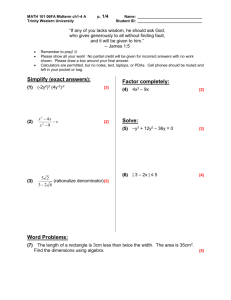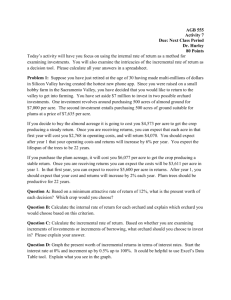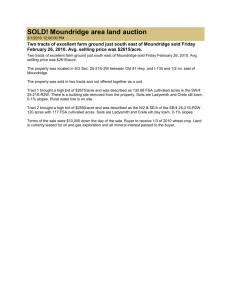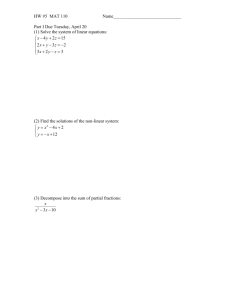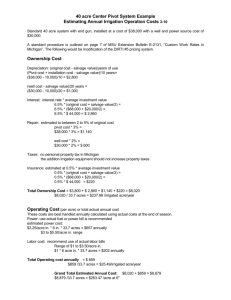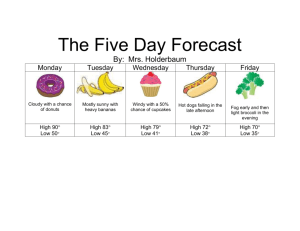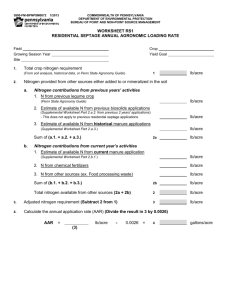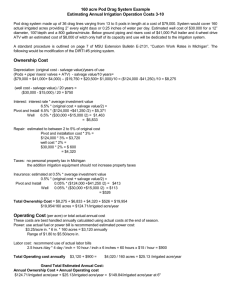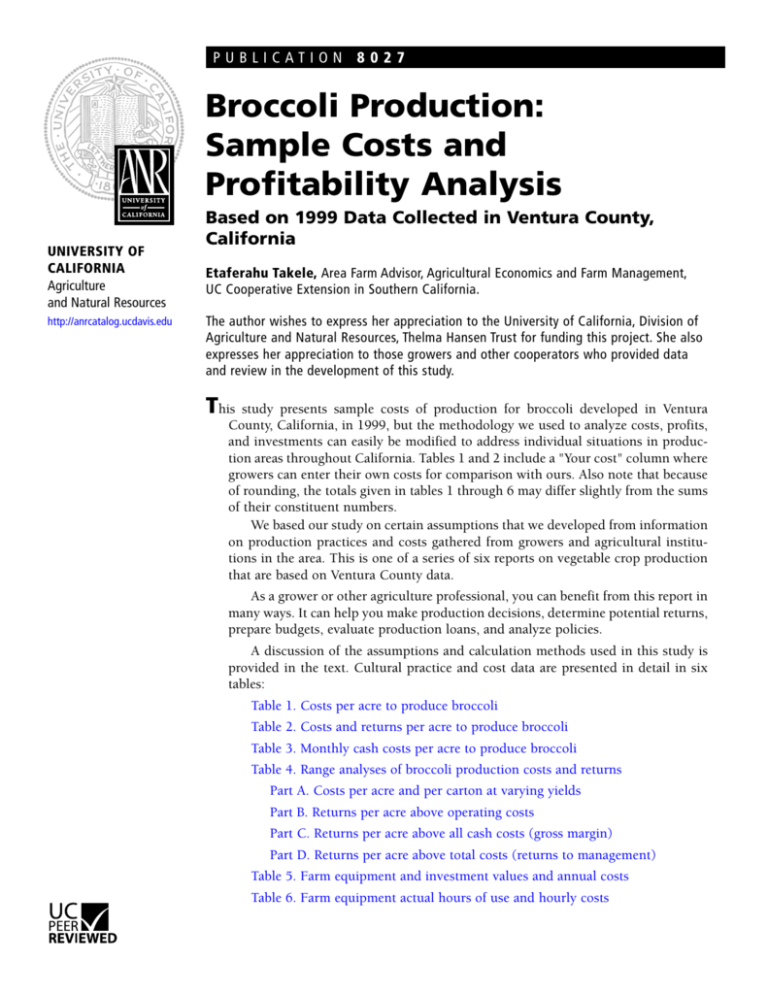
PUBLICATION 8027
Broccoli Production:
Sample Costs and
Profitability Analysis
UNIVERSITY OF
CALIFORNIA
Agriculture
and Natural Resources
http://anrcatalog.ucdavis.edu
Based on 1999 Data Collected in Ventura County,
California
Etaferahu Takele, Area Farm Advisor, Agricultural Economics and Farm Management,
UC Cooperative Extension in Southern California.
The author wishes to express her appreciation to the University of California, Division of
Agriculture and Natural Resources, Thelma Hansen Trust for funding this project. She also
expresses her appreciation to those growers and other cooperators who provided data
and review in the development of this study.
This study presents sample costs of production for broccoli developed in Ventura
County, California, in 1999, but the methodology we used to analyze costs, profits,
and investments can easily be modified to address individual situations in production areas throughout California. Tables 1 and 2 include a "Your cost" column where
growers can enter their own costs for comparison with ours. Also note that because
of rounding, the totals given in tables 1 through 6 may differ slightly from the sums
of their constituent numbers.
We based our study on certain assumptions that we developed from information
on production practices and costs gathered from growers and agricultural institutions in the area. This is one of a series of six reports on vegetable crop production
that are based on Ventura County data.
As a grower or other agriculture professional, you can benefit from this report in
many ways. It can help you make production decisions, determine potential returns,
prepare budgets, evaluate production loans, and analyze policies.
A discussion of the assumptions and calculation methods used in this study is
provided in the text. Cultural practice and cost data are presented in detail in six
tables:
Table 1. Costs per acre to produce broccoli
Table 2. Costs and returns per acre to produce broccoli
Table 3. Monthly cash costs per acre to produce broccoli
Table 4. Range analyses of broccoli production costs and returns
Part A. Costs per acre and per carton at varying yields
Part B. Returns per acre above operating costs
Part C. Returns per acre above all cash costs (gross margin)
Part D. Returns per acre above total costs (returns to management)
Table 5. Farm equipment and investment values and annual costs
Table 6. Farm equipment actual hours of use and hourly costs
ANR Publication 8027
BROCCOLI PRODUCTION: Sample Costs and Profitability Analysis
Broccoli is grown for both the fresh and processed markets. Market price sometimes determines how broccoli is harvested. This study assumes that the costs of
production are the same for fresh market and processed crops except for harvesting
(picking and packing) and selling costs, crop prices, and yield.
S T U DY A S S U M P T I O N S
This report is based on a 1,300-acre vegetable farm, the average size of farm for the
growers we interviewed. Most land used for vegetable crops in Ventura County produces two or more crops a year. Each crop is planted and harvested multiple times
a year. Planting, harvesting, and selling of vegetable crops are year-round activities
for growers, farm workers, and sellers.
We calculated our costs assuming that at least two crops are produced on each
acre, resulting in a total of 2,600 farmed acres per year. For our study, the crops
grown on the farm include broccoli, bell pepper, celery, spinach, loose-leaf lettuce,
and cilantro (we have issued a report similar to this one for each of these crops).
This crop mix is not present, of course, on every farm in Ventura County, but several farms in our interview pool did produce all six crops.
The growing period for each crop varies depending on time of planting.
Consequently, production costs—particularly for irrigation, disease and pest management, and overhead—would be expected to vary. We based our study on an average growth period of minimum and maximum days. Prices used for materials,
equipment, contract services, and labor wages (unless otherwise specified) are for
the year 1999.
C U LT U R A L P R A C T I C E S A N D P R O D U C T I O N I N P U T S
Land preparation. Different types of fields and management preferences require
different types of land preparation. Most growers in our interview pool performed
several operations including multiple discing, ripping the soil to break up any
underlying compacted soil, plowing, leveling using a triplane, chiseling, furrowing,
listing, and shaping beds. Preplant fertilizer was applied together with the listing
before the ground was shaped and rolled into beds.
Stand establishment. Broccoli is grown primarily in the Southern Desert Valley, the
South Coast, the Central Coast, and the Central Valley areas of California. The primary varieties produced in Ventura County are Emperor, Greenbelt, and Marathon.
All require similar cultural, harvesting, and marketing requirements.
Seeding rates vary depending on spacing. For this study, a rate of approximately 64,000 seeds per acre is used. A planted bed consists of two rows to a bed with
bed centers 40 inches apart and seeds 5 inches apart within the row.
Weed management. Many growers in Ventura County use herbicides to control a
wide range of grass and broadleaf weeds such as burning nettle (Urtica urens),
sowthistle (Sonchus oleraceus), and prickly lettuce (Lactuca serriola). Growers indicated that the application of an herbicide within 3 to 6 weeks of planting virtually
eliminates any need for hoeing.
Fertilization. Preplant fertilizer of nitrogen (N) and phosphorous (P) is in most
cases applied together with the listing before the ground is shaped and rolled into
beds.
2
ANR Publication 8027
BROCCOLI PRODUCTION: Sample Costs and Profitability Analysis
Fertilizer applications during the growth period are mostly N and are applied via
the furrow irrigation system. The amount and type of fertilizer we included in this
study are based on an average of what most growers applied.
Irrigation. During germination, irrigation is applied via a sprinkler system. Growers
can purchase or rent sprinkler irrigation systems. We calculated costs for this study
based on ownership of an existing sprinkler irrigation system.
Growers can irrigate a field one portion at a time, moving pumps, pipes, and fittings manually from field to field. For this study, we assumed that sufficient pumps,
pipes, and fittings are available to irrigate 430 acres at a time. Pipes are transported
using a trailer and a tractor. Spreading the pipes takes 90 minutes of manual labor
per acre. Removing pipes takes about the same amount of time.
After seedlings have broken through the soil, growers convert the irrigation to a
furrow system. Irrigation labor for inspection and maintenance of the system is estimated at about 30 minutes per acre per irrigation for sprinklers and about 20 minutes per acre per irrigation for furrow irrigation.
Energy use for pumping includes both diesel fuel and electric power depending
on the irrigation system. The amount of diesel and electricity consumption depends
on pump horsepower (HP). In our study, we used a 100-HP diesel pump and a 70HP electric pump. We estimated that 21 gallons per acre of diesel and about 715
kilowatts (KW) of electricity per acre would be needed during the production period for broccoli.
The cost of water to irrigate crops varies greatly from region to region in Ventura
County and also depends on whether district or well water is used. In this study,
production is in the Oxnard plains where growers use both well and district water.
We calculated the water cost at $82 per acre-foot. This rate is a weighted average for
pumping costs and district charges, assuming that one-third of the water comes from
wells and the remaining two-thirds from districts. Commonly, an irrigation of a
broccoli crop uses about 30 acre-inches of water.
Pest and disease management. Insects that can affect broccoli production include
cabbage and seedcorn maggots (Delia spp.), flea beetles (Phyllotreta sp. and Epitrix
cucumeris), wireworms (Elateridae sp.), and cutworms (Agrostis sp. and Peridroma
saucia). Most of these pests can be treated at the larval stage. Growers usually rotate
insecticides in order to slow potential pest resistance. Written recommendations
from state of California-licensed pest control advisers are required for pesticide use.
For information and pesticide use permits, contact your county Agricultural
Commissioner's office. You can also obtain pest management information from the
University of California on the UC Statewide Integrated Pest Management Project
website, http://www.ipm.ucdavis.edu.
Soilborne pests (Heterodera spp.) and root knot nematodes (Meloidogyne spp.)
are an isolated problem and are usually controlled with soil fumigation. In this study,
we did not include soilborne pest control. Growers are advised to adjust their management practices, as necessary.
Depending on the region, a number of diseases may infect broccoli during any
phase of growth. The most common diseases affecting broccoli in Ventura County
are downey mildew (Pernospora parasitica) and broccoli head rot caused by
Pseudomonas bacteria or Alternaria sp. fungi. Growers may or may not apply a fungicide to combat these diseases. Usually, treatment of these diseases is only necessary
during the early stages of development. Accordingly, this study assumes that fungicide treatment is used as a preventive measure.
3
ANR Publication 8027
BROCCOLI PRODUCTION: Sample Costs and Profitability Analysis
HARVEST AND SELL
Because broccoli is grown for both fresh and processed markets, the market price
sometimes determines how broccoli is harvested. In this study, we assumed that 60
percent of the crop would be packed for fresh market and 40 percent processed
(based on 1997 and 1998 Ventura County Agricultural Commissioner Crop
Reports). Most fields are harvested two or three times, the first harvest being larger
than subsequent ones.
Broccoli is harvested and packed into cartons. A carton typically contains 14 to
18 bunches of broccoli and weighs about 22 pounds. A bunch contains 2 to 4 heads
of broccoli. After it is packed, it is quickly transported to a storage facility where it
is palletized and cooled at a scientifically recommended temperature.
Harvesting costs in this study include cartons, picking and packing, loading, and
hauling the crop to the nearest cooling facility. Harvesting cost estimates obtained
from our interviews include $1.10 for each carton itself (for fresh crop), $1.00 per
carton for picking and packing fresh broccoli, $0.50 per carton for picking broccoli
for processing, and $0.65 per carton for loading and hauling the crop to fresh market and processing. Selling costs are estimated at $0.50 and $0.25 per carton, respectively, for fresh market and processing.
We did not include cooling costs because we did not get sufficient information
on actual costs or usage of cooling facilities.
I N T E R E S T O N O P E R AT I N G C A P I TA L
We calculated interest on operating capital at a nominal rate of 10 percent per year.
Interest on operating capital reflects the costs of borrowing money or an opportunity cost for using in-house funds. Interest on operating capital is charged until
income is received from the crop at harvest. A nominal interest rate is the current
market cost of borrowed funds during the production year.
DISPOSING OF CROP RESIDUE
After harvest, the field is disced twice to incorporate all crop residues into the soil.
CASH OVERHEAD COSTS
Land rent. Land rental contracts and charges for agricultural production can vary
widely by region and also depend on the availability of well water on the property.
In Ventura County, if there is a well on the property, the landlord often pays for the
pump, the permanent parts of the irrigation facilities, and the costs of maintaining
the well. The grower is generally responsible for the costs of energy needed to pump
water.
Most of the growers we interviewed rented land with wells that provide a portion of their farms’ water requirements. We do not have sufficient data, however, to
compare land rents for properties with and without well water. We suggest that
growers evaluate the value and costs associated with well water and take this into
account when determining an appropriate cost for land rent.
This study assumes an average cash rent of $1,320 per acre per year ($110 per
acre per month). Using a 4-month average growth period from land preparation to
harvest, the broccoli enterprise is charged a rent of $440 per acre per crop.
4
ANR Publication 8027
BROCCOLI PRODUCTION: Sample Costs and Profitability Analysis
Property taxes. Counties charge a base property tax rate of 1 percent on the
assessed value of the property, including equipment, buildings, and improvements.
Special assessment districts in some counties charge additional taxes on property.
For our study, we calculated county taxes at 1 percent of the value of the property.
Insurance. Growers also carry insurance for property protection, which is typically
calculated at 0.713 percent of the average value of assets. In addition, a farm of the
size specified in this report would carry liability insurance of $1,040 per year to
cover accidents on the entire farm.
Supervisors, foremen, and management. Interview information indicated that the
size of farm we used in this study would require an average of about three employees who are supervisors or foremen. Wages are estimated at $110 per acre per year.
For the 4-month growth period, the broccoli enterprise is charged $36 per acre per
crop for supervisors and foremen.
Most growers in the survey did not provide management costs, and the wide
variations in wages and salaries for professional managers make it difficult to
approximate a typical situation. We suggest that, after all production costs have been
subtracted from receipts, the residual should be referred to as returns to management.
Office expenses. Expenses in this category include office supplies, telephone service, operating costs for a fax machine, photocopier, and computer, bookkeeping,
accounting, legal fees, and so on. Our interview average for office expenses is about
$360 per acre per year. For the 4 months of broccoli crop production, office expenses are around $120 per acre per crop.
NON-CASH OVERHEAD COSTS
We calculated the non-cash overhead or ownership costs of assets (including farm
equipment and other investments like an irrigation system, buildings, a fuel tank,
and pumps) using the capital recovery method. This method helps growers calculate an annual amount of money to charge the enterprise so that the value of assets
is recovered within a specified period of time at a designated rate of interest. The rate
of interest used to calculate ownership cost is 7.40 percent—California’s long-term
average return rate on agricultural production assets from current income. Because
farms use a mix of old and new equipment, we evaluated the value of the equipment
complement at 60 percent of new prices.
E Q U I P M E N T O P E R AT I N G C A S H C O S T S
Equipment operating cash costs for fuel, lubrication, and repairs are calculated using
formulas and coefficients developed by the American Society of Agricultural
Engineers (ASAE). Repair costs are based on purchase price, annual hours of use,
total hours of life, and repair coefficients formulated by the ASAE. Fuel and lubrication costs are also determined by ASAE equations based on machinery horsepower (maximum PTO hp) and type of fuel used. Fuel costs are calculated using average (1996 to 1999 period), on-farm delivery prices of $0.72 per gallon for diesel and
$1.20 per gallon for gasoline. The cost of energy for electric irrigation pumps is
$0.105 per KW.
5
6
BROCCOLI PRODUCTION: Sample Costs and Profitability Analysis
ANR Publication 8027
LABOR
Labor includes owner and hired operator labor with the same wage rate. Hourly labor
wages are $7.50 per hour for machine operators and $6.25 per hour for other workers.
These wages are averages based on data from the growers we interviewed. Growers also
pay 20 to 34 percent for benefits, which include Workers Compensation, Social
Security, Medicare insurance, and other possible benefits. In this study, we assumed an
additional 34 percent for benefits, which brings the labor rate to about $10.00 per hour
for machine operators and $8.40 per hour for other workers.
Table A. Harvested acreage, average yield, and
average prices for broccoli, Ventura County,
1995–1999
Year
1995
1996
1997
1998
1999
Harvested Cartons Price per
acreage per acre* carton ($)
3,791
566
6.38
4,804
604
6.17
4,454
624
8.20
4,667
585
6.73
4,956
635
6.12
Approximate
average 4,534
*One carton equals 22 pounds.
600
6.70
We calculated 20 percent additional labor time for machinery operation
than the time estimated for actual operation. This percentage accounts for the
setup, moving, maintenance, and repair of equipment.
PRICES AND YIELDS
Growers did not provide sufficient data on yield or prices, so we used average
prices and yields provided by Ventura County Agricultural Crop Reports for
the 1995 to 1999 period (table A) to estimate gross returns. It should be noted
that the county prices and yields for broccoli are reported for the total crop
(fresh and processed combined). According to the county report, about 60
percent of the crop is packed fresh and 40 percent is processed. The county
crop reports use free on board (f.o.b.) prices to estimate growers’ returns.
These prices include harvesting and packing costs, but growers’ prices may be
different if they incur postharvest costs such as selling and cooling.
SUMMARY OF COSTS
Our sample estimate of the total cost of broccoli production in Ventura County is
$3,340 per acre (tables 1 and 2). Table 1 presents costs by type of activity, and table 2
presents costs by type of input.
The pie graph that follows shows the breakdown of costs. It consists of about 29
percent for land preparation, planting, and growing costs, 45 percent for harvest and
postharvest costs, 20 percent for cash overhead, 1 percent for interest on operating capital, and 5 percent for non-cash overhead costs. Land preparation, planting, and growing costs include fuel, lube, and machinery repairs, as well as materials and labor for
all production practices. Harvesting costs in this study include the cost of the cartons,
picking and packing, loading and hauling to the nearest cooling facility, and selling.
Postharvest costs in this study include two discings. Cash overhead costs include land
rent, office expenses, liability insurance, supervisor and foremen wages, property taxes,
property insurance, and investment repairs.
Figure 1. Proportion of production costs for broccoli, Ventura County, 1999.
Interest on Operating Capital
1%
Harvest and Postharvest Costs
45%
Cash Overhead
Non-Cash Overhead
20%
5%
Preplant, Plant, and
Growing Cost
29%
ANR Publication 8027
BROCCOLI PRODUCTION: Sample Costs and Profitability Analysis
P R O F I T A B I L I T Y A N A LY S I S
We analyzed profitability using break-even costs per carton and gross and economic margins. Break-even costs allow growers to compare expected market prices with
the unit cost of production.
Gross margin (or returns above cash costs) is what growers often refer to as profit if there is no debt on the farming operation. It approximates the return to management and investment. If you deduct depreciation, it also approximates taxable
income.
Economic profit (or returns above total cost including management) is a very
useful measure of how attractive the enterprise is for potential investors and entrants
into the business. Economic profit can be positive or zero. A zero economic profit
should not be alarming if all costs, including the owners’ labor and management
costs, are included (and assumed paid) in the production cost. In this study, we do
not include management charges, so the return after all costs are deducted reflects
return to management.
Given the assumptions upon which we based this cost study, the break-even
price for the 5-year county average yield of 600 cartons per acre is estimated at about
$5.28 per carton to cover all cash costs and $5.57 per carton to cover total costs
(table 4, part A). At the same time, the break-even yield for the county average price
of $6.70 per carton is about 472 cartons per acre for cash costs and 499 cartons per
acre for total costs. Break-even price is calculated as the cost of production per acre
divided by the yield per acre. Break-even yield is calculated as cost of production
divided by price per carton.
Gross margin for the county average yield and price is estimated at $855 per acre
(table 4, part C). This is calculated as gross returns (price multiplied by yield) minus
cash costs of production. Returns to management for the county average yield and
price are estimated at $680 per acre (table 4, part D). This figure is calculated as
gross returns minus total (cash and non-cash) costs of production.
Crop yield and prices received by growers, however, vary depending on several
factors. Prices for broccoli in particular vary based on what proportions of the crop
are marketed as fresh and processed. Selling and cooling costs also influence prices,
depending on whether the costs are incurred by the grower or by the buyer.
We have provided a range analyses of price and yield variations on profitability
so that growers can determine their specific situation. The range analyses include
break-even prices at various yield. Gross margins and returns to management are
also calculated at various yield and price combinations. The gross margin and
returns to management ranges are analyzed at increments of $0.10 per carton for
prices and 50 cartons per acre for yield (table 4, parts A through D).
7
ANR Publication 8027
8
BROCCOLI PRODUCTION: Sample Costs and Profitability Analysis
Table 1. Costs per acre to produce broccoli, Ventura County, 1999 (labor rates: $10.00/hr for machine labor, $8.40/hr for
non-machine labor; interest rate: 10.00%)
Operation
time
(hrs/ac)
Labor
cost
Preplant:
Disc 2×
Rip 2×
Plow
Disc 3×
Landplane 3×
Chisel
List & preplant fertilize
Shape beds & roll
TOTAL PREPLANT COSTS
0.38
0.57
0.21
0.57
0.55
0.25
0.33
0.23
3.09
5
7
3
7
7
3
7
3
40
5
1
3
8
6
4
4
2
33
0
0
0
0
0
0
66
0
66
Plant:
Seeds (plant & labor)
TOTAL PLANT COSTS
0.22
0.22
3
3
4
4
2
Operation
Total
cost
Your
cost ($)
0
0
0
0
0
0
0
0
0
9
8
6
15
13
7
77
5
139
___________
___________
___________
___________
___________
___________
___________
___________
___________
150
150
0
0
157
157
___________
___________
2
83
0
88
___________
15
19
1
0
0
36
0
0
16
55
___________
___________
0
15
3
13
0
1
0
0
27
0
0
146
0
0
0
0
27
16
3
159
___________
___________
___________
___________
0
0
10
0
0
7
63
64
53
0
0
0
63
64
70
___________
___________
___________
5
6
19
107
4
5
8
26
64
0
0
535
0
0
0
0
72
10
27
669
___________
___________
___________
___________
0
0
0
1,506
0
1,506
___________
0
0
0
1,506
0
1,506
___________
Growing:
Weed management 1×
0.21
Sprinkler setup (machine
& labor)
0.20
Irrigate 5× (sprinkler)
2.25
Fuel/electricity for
irrigation pumps (growing)
0
Sprinkler removal (machine & labor) 0.20
Furrow setup (labor)
0.40
Irrigate 5× (furrow)
1.50
Electricity for irrigation
pump (growing)
0
Fertilize
0
Pest management 4×
0.82
Disease management 2×
& pest management 2×
0.41
Cultivate 2×
0.46
Pickup truck
1.60
TOTAL GROWING COSTS
8.05
Harvest & Sell
Harvest & sell
TOTAL HARVEST
& SELL COSTS
Costs per acre ($)
Fuel, lube, Material Custom/
& repairs
cost
rent
Continued next page
ANR Publication 8027
9
BROCCOLI PRODUCTION: Sample Costs and Profitability Analysis
Table 1. Continued
Operation
Operation
time
(hrs/ac)
Labor
cost
0.38
5
5
0
0
9
___________
0.38
5
5
0
0
9
___________
33
___________
2,513
___________
Disposing of Crop Residue:
Postharvest disc 2×
TOTAL DISPOSING OF
CROP RESIDUE COSTS
Costs per acre ($)
Fuel, lube, Material Custom/
& repairs
cost
rent
Interest on operating capital
@ 10.00%
TOTAL OPERATING COSTS/ACRE
154
68
2,258
0
Cash Overhead:
Land rent
Office expense
Liability insurance
Supervisors & foreman
Property taxes
Property insurance
Investment repairs
TOTAL CASH OVERHEAD COSTS
TOTAL CASH COSTS/ACRE
Costs per
producing
acre ($)
Non-cash Overhead:
Investment
Shop building
Shop tools
Fuel tanks & pumps
Irrigation pump
Sprinklers and pipes
Equipment
TOTAL NON-CASH OVERHEAD COSTS
TOTAL COSTS/ACRE
23
12
15
333
549
193
1,125
Annual
cost:
capital
recovery ($)
3
1
2
46
76
49
176
Total
cost
Your
cost ($)
440
120
0
36
6
4
45
652
___________
___________
___________
___________
___________
___________
___________
___________
3,165
___________
Total
cost ($)
Your
cost ($)
3
1
2
46
76
49
176
___________
___________
___________
___________
___________
___________
___________
3,340
___________
ANR Publication 8027
BROCCOLI PRODUCTION:
Sample Costs and Profitability
10
Analysis
Table 2. Costs and returns per acre to produce broccoli, Ventura County, 1999 (labor rates: $10.00/hr for machine
labor, $8.40/hr for non-machine labor; interest rate: 10.00%)
Gross Returns
TOTAL GROSS RETURNS
FOR BROCCOLI
Value or
cost per
acre ($)
Your
cost ($)
4,020
___________
4,020
___________
66
64
___________
___________
188.00
83.00
150
83
___________
___________
acre-inch
6.83
182
___________
gallon
0.72
15
___________
KW
acre
acre
0.105
98.00
17.00
75
98
17
___________
___________
___________
carton
carton
carton
carton
carton
carton
hour
hour
1.10
1.00
0.65
0.50
0.50
0.25
10.00
8.40
396
360
390
120
180
60
91
63
___________
___________
___________
___________
___________
___________
___________
___________
gallon
gallon
1.20
0.72
5
29
5
29
33
2,513
___________
___________
___________
___________
___________
1,507
___________
Quantity
per acre
Unit
600.00
carton
Operating Costs:
Fertilize:
16-20-0 (preplant)
400.00
AN 20 (growing)
50.00
Seed:
Broccoli seed
0.80
Weed management
1.00
Water:
Water
26.65
Fuel (pump):
Booster pump fuel
21.00
Electricity (pump):
Low-pressure pump
715.23
Pest management
1.00
Disease management
1.00
Harvest & Sell:
Cartons
360.00
Pick & pack (fresh)
360.00
Load & haul
600.00
Pick (process)
240.00
Selling (fresh)
360.00
Selling (processed)
240.00
Labor (machine)
9.12
Labor (non-machine)
7.47
Fuel:
Gasoline
4.00
Diesel
39.62
Lube
Machinery repair
Interest on operating capital @ 10.00%
TOTAL OPERATING COSTS/ACRE
NET RETURNS ABOVE OPERATING COSTS
pound
gallon
pound
acre
Price or
cost per
unit ($)
6.70
0.165
1.05
Continued next page
ANR Publication 8027
11
BROCCOLI PRODUCTION: Sample Costs and Profitability Analysis
Table 2. Continued
Quantity
per acre
Cash Overhead Costs:
Land rent
Office expense
Liability insurance
Supervisors & foreman
Property taxes
Property insurance
Investment repairs
TOTAL CASH OVERHEAD COSTS/ACRE
TOTAL CASH COSTS/ACRE
Non-cash Overhead Costs (Capital Recovery):
Shop building
Shop tools
Fuel tanks & pumps
Irrigation pump
Sprinklers & pipes
Equipment
TOTAL NON-CASH OVERHEAD COSTS/ACRE
TOTAL COSTS/ACRE
NET RETURNS ABOVE TOTAL COSTS
Unit
Price or
cost per
unit ($)
Value or
cost per
acre ($)
Your
cost ($)
440
120
0
36
6
4
45
652
___________
___________
___________
___________
___________
___________
___________
___________
3,165
___________
3
1
2
46
76
49
176
___________
___________
___________
___________
___________
___________
___________
3,340
___________
680
___________
ANR Publication 8027
12
BROCCOLI PRODUCTION: Sample Costs and Profitability Analysis
Table 3. Monthly cash costs per acre to produce broccoli, Ventura County, 1999
Operation
Preplant:
Disc 2×
Rip 2×
Plow
Disc 3×
Landplane 3×
Chisel
Listing & preplant fertilize
Shape beds & roll
TOTAL PREPLANT COSTS
Month 1
Costs per acre ($)
Month 3
Month 4
9
8
6
15
13
7
77
5
139
Plant:
Seeds (plant & labor)
TOTAL PLANT COSTS
Growing:
Weed management 1×
Sprinkler setup (machine & labor)
Irrigate 5× (sprinkler)
Fuel/electricity for
irrigation pumps (growing)
Sprinkler removal (machine & labor)
Furrow setup (labor)
Irrigate 5× (furrow)
Electricity for irrigation
pump (growing)
Fertilize
Pest management 4×
Disease management 2×
& pest management 2×
Cultivate 2×
Pickup truck
TOTAL GROWING COSTS
Month 2
9
8
6
15
13
7
77
5
139
157
157
157
157
88
16
55
88
16
55
27
16
3
32
27
16
3
159
64
64
26
26
31
26
38
39
63
64
70
27
5
7
205
45
5
7
289
7
168
72
10
27
669
1,506
1,506
1,506
1,506
9
9
9
9
10
7
7
Harvest & Sell:
Harvest & sell
TOTAL HARVEST
& SELL COSTS
Disposing of Crop Residue:
Postharvest disc 2×
TOTAL DISPOSING OF
CROP RESIDUE COSTS
Interest on operating capital
@ 10.00%
Total
1
5
7
21
33
TOTAL OPERATING COSTS/ACRE
147
451
211
1,704
2,513
Cash Overhead:
Land rent
Office expense
Liability insurance
Supervisors & foreman
Property taxes
Property insurance
Investment repairs
TOTAL CASH OVERHEAD COSTS
110
30
0
9
3
2
11
166
110
30
0
9
110
30
0
9
11
160
11
160
110
30
0
9
3
2
11
166
440
120
0
36
6
4
45
652
313
611
371
1,870
3,165
TOTAL CASH COSTS/ACRE
ANR Publication 8027
13
BROCCOLI PRODUCTION: Sample Costs and Profitability Analysis
Table 4. Range analyses of broccoli production costs and returns, Ventura County, 1999
Costs per acre ($) for various cartons-per-acre yields
450
500
550
600
650
700
750
Part A. Costs per Acre and per Carton at Varying Yields
Operating costs/acre:
Preplant cost
Plant cost
Growing cost
Harvest & sell cost
Disposing of crop residue cost
139
157
669
1,129
9
139
157
669
1,255
9
139
157
669
1,380
9
139
157
669
1,506
9
139
157
669
1,631
9
139
157
669
1,757
9
139
157
669
1,882
9
30
31
32
33
34
36
37
TOTAL OPERATING COSTS/ACRE 2,133
TOTAL OPERATING COSTS/CARTON 4.74
2,260
4.52
2,386
4.34
2,513
4.19
2,639
4.06
2,766
3.95
2,892
3.86
652
652
652
652
652
652
652
2,785
6.19
2,911
5.82
3,038
5.52
3,165
5.27
3,291
5.06
3,418
4.88
3,544
4.73
NON-CASH OVERHEAD
COSTS/ACRE
176
176
176
176
176
176
176
TOTAL COSTS/ACRE
TOTAL COSTS/CARTON
2,961
6.58
3,087
6.17
3,214
5.84
3,340
5.57
3,467
5.33
3,593
5.13
3,720
4.96
1,134
1,189
1,244
1,299
1,354
1,409
1,464
1,327
1,387
1,447
1,507
1,567
1,627
1,687
1,521
1,586
1,651
1,716
1,781
1,846
1,911
1,714
1,784
1,854
1,924
1,994
2,064
2,134
1,908
1,983
2,058
2,133
2,208
2,283
2,358
675
735
795
855
915
975
1,035
869
934
999
1,064
1,129
1,194
1,259
1,062
1,132
1,202
1,272
1,342
1,412
1,482
1,256
1,331
1,406
1,481
1,556
1,631
1,706
500
560
620
680
740
800
860
693
758
823
888
953
1,018
1,083
887
957
1,027
1,097
1,167
1,237
1,307
1,080
1,155
1,230
1,305
1,380
1,455
1,530
Interest on operating capital
CASH OVERHEAD COSTS/ACRE
TOTAL CASH COSTS/ACRE
TOTAL CASH COSTS/CARTON
Part B. Returns per Acre above Operating Costs
Price ($/carton):
$6.40
$6.50
$6.60
$6.70
$6.80
$6.90
$7.00
747
792
837
882
927
972
1,017
940
990
1,040
1,090
1,140
1,190
1,240
Part C. Returns per Acre above All Cash Costs (gross margin)
Price ($/carton):
$6.40
$6.50
$6.60
$6.70
$6.80
$6.90
$7.00
95
140
185
230
275
320
365
289
339
389
439
489
539
589
482
537
592
647
702
757
812
Part D. Returns per Acre above Total Costs (returns to management)
Price ($/carton):
$6.40
$6.50
$6.60
$6.70
$6.80
$6.90
$7.00
–81
–36
9
54
99
144
189
113
163
213
263
313
363
413
306
361
416
471
526
581
636
ANR Publication 8027
14
BROCCOLI PRODUCTION: Sample Costs and Profitability Analysis
Table 5. Farm equipment and investment values and annual costs based on 2,600 annual farmed acres, Ventura
County, 1999
Costs
Equipment
Value:
1999
price ($)
120 HP Tractor 4WD (#1)
120 HP Tractor 4WD (#2)
120 HP Tractor 4WD (#3)
200 HP 4WD Tractor
45 HP 2WD Tractor
Bed shaper
Chisel – 14' (#1)
Chisel – 14' (#2)
Cultivator – 4-row 40" (#1)
Cultivator – 4-row 40" (#2)
Disc – 21' (#1)
Disc – 21' (#2)
Disc – 21' (#3)
Disc – 21' (#4)
Disc – 21' (#5)
Disc – 21' (#6)
Disc – 21' (#7)
Lister (#1)
Lister (#2)
Pickup truck 1/2 ton (#1)
Pickup truck 1/2 ton (#2)
Pickup truck 1/2 ton (#3)
Pickup truck 1/2 ton (#4)
Pickup truck 1/2 ton (#5)
Planter – 6-row
Plow – 6-bottom
Sprayer 600 gallon (#1)
Sprayer 600 gallon (#2)
Subsoiler – 12' (#1)
Subsoiler – 12' (#2)
Trailer
Triplane – 14' (#1)
Triplane – 14' (#2)
Triplane – 14' (#3)
TOTAL EQUIPMENT
75,180
75,180
75,180
135,500
23,030
8,900
2,270
2,270
7,130
7,130
16,510
16,510
16,510
16,510
16,510
16,510
16,510
6,000
6,000
17,160
17,160
17,160
17,160
17,160
8,900
12,000
100,000
100,000
6,490
6,490
2,000
18,230
18,230
18,230
915,710
60% OF NEW COST*
549,426
Life (yrs)
6
5
6
6
10
3
3
3
3
3
5
5
5
5
5
5
5
4
4
2
2
2
2
2
5
3
5
5
2
2
2
5
5
5
Salvage
value
($)
Capital
recovery
($)
Annual cash
overhead ($)
Insurance
Taxes
Total
annual
costs ($)
7,518
7,518
7,518
13,550
2,303
890
227
227
713
713
1,651
1,651
1,651
1,651
1,651
1,651
1,651
600
600
1,716
1,716
1,716
1,716
1,716
890
180
10,000
10,000
649
649
200
1,823
1,823
1,823
90,551
14,927
17,236
14,927
26,904
3,176
3,140
801
801
2,516
2,516
3,785
3,785
3,785
3,785
3,785
3,785
3,785
1,653
1,653
8,716
8,716
8,716
8,716
8,716
2,040
4,550
22,926
22,926
3,297
3,297
1,016
4,179
4,179
4,179
232,916
295
295
295
531
90
35
9
9
28
28
65
65
65
65
65
65
65
24
24
67
67
67
67
67
35
43
392
392
25
25
8
71
71
71
3,587
413
413
413
745
127
49
12
12
39
39
91
91
91
91
91
91
91
33
33
94
94
94
94
94
49
61
550
550
36
36
11
100
100
100
5,031
15,636
17,944
15,636
28,181
3,393
3,224
822
822
2,583
2,583
3,941
3,941
3,941
3,941
3,941
3,941
3,941
1,710
1,710
8,878
8,878
8,878
8,878
8,878
2,124
4,655
23,868
23,868
3,358
3,358
1,035
4,351
4,351
4,351
241,535
54,331
139,750
2,152
3,019
144,921
Continued next page
ANR Publication 8027
15
BROCCOLI PRODUCTION: Sample Costs and Profitability Analysis
Table 5. Continued
Costs
Investment
Value:
1999
price ($)
Life (yrs)
Fuel tanks & pumps
38,100
Irrigation pump
866,666
Shop building
60,000
Shop tools
30,000
Sprinklers & pipes
1,427,530
TOTAL INVESTMENT 2,422,296
Business Overhead
Land rent
Liability insurance
Office expense
Supervisors & foreman
*Used to reflect a mix of new and used equipment.
15
10
15
15
10
Salvage
value
($)
3,810
86,667
6,000
3,000
142,753
242,230
Capital
Annual cash
Total
recovery
overhead ($)
annual
($) Insurance Taxes Repairs costs ($)
4,142
119,529
6,524
3,262
196,883
330,340
149
210
1,828
6,329
3,399
4,767 41,599 169,293
235
330
2,880
9,969
118
165
1,440
4,984
5,598
7,851 68,521 278,853
9,499 13,323 116,268 469,429
Enterprise/
farm size
Unit
Price per
unit ($)
Total
cost ($)
2,600
2,600
2,600
2,600
acre
acre
acre
acre
440
0.40
120
36
1,144,000
1,040
312,000
93,600
ANR Publication 8027
16
BROCCOLI PRODUCTION: Sample Costs and Profitability Analysis
Table 6. Farm equipment actual hours of use and hourly costs based on 2,600 annual farmed acres, Ventura County, 1999
Description
Actual
hours
of use
Capital
recovery
120 HP Tractor 4WD (#1)
120 HP Tractor 4WD (#2)
120 HP Tractor 4WD (#3)
200 HP 4WD Tractor
45 HP 2WD Tractor
Bed shaper
Chisel – 14' (#1)
Chisel – 14' (#2)
Cultivator – 4-row 40" (#1)
Cultivator – 4-row 40" (#2)
Disc – 21' (#1)
Disc – 21' (#2)
Disc – 21' (#3)
Disc – 21' (#4)
Disc – 21' (#5)
Disc – 21' (#6)
Disc – 21' (#7)
Lister (#1)
Lister (#2)
Pickup truck 1/2 ton (#1)
Pickup truck 1/2 ton (#2)
Pickup truck 1/2 ton (#3)
Pickup truck 1/2 ton (#4)
Pickup truck 1/2 ton (#5)
Planter – 6-row
Plow – 6-bottom
Sprayer 600 gallon (#1)
Sprayer 600 gallon (#2)
Subsoiler – 12' (#1)
Subsoiler – 12' (#2)
Trailer
Triplane – 14' (#1)
Triplane – 14' (#2)
Triplane – 14' (#3)
2,500
3,000
2,500
2,600
1,200
670
740
740
740
740
500
500
500
500
500
500
500
500
500
1,000
1,000
1,000
1,000
1,000
500
610
2,000
2,000
840
840
1,000
540
540
540
3.58
3.45
3.58
6.21
1.59
2.81
0.65
0.65
2.04
2.04
4.54
4.54
4.54
4.54
4.54
4.54
4.54
1.98
1.98
5.23
5.23
5.23
5.23
5.23
2.45
4.48
6.88
6.88
2.35
2.35
0.61
4.64
4.64
4.64
Costs per hour ($)
Operating
Cash overhead
Fuel
Insurance
Taxes
Repairs
& lube
0.07
0.06
0.07
0.12
0.05
0.03
0.01
0.01
0.02
0.02
0.08
0.08
0.08
0.08
0.08
0.08
0.08
0.03
0.03
0.04
0.04
0.04
0.04
0.04
0.04
0.04
0.12
0.12
0.02
0.02
0.01
0.08
0.08
0.08
0.10
0.08
0.10
0.17
0.06
0.04
0.01
0.01
0.03
0.03
0.11
0.11
0.11
0.11
0.11
0.11
0.11
0.04
0.04
0.06
0.06
0.06
0.06
0.06
0.06
0.06
0.17
0.17
0.03
0.03
0.01
0.11
0.11
0.11
1.89
1.91
1.89
3.54
1.03
1.53
0.44
0.44
1.39
1.39
3.65
3.65
3.65
3.65
3.65
3.65
3.65
2.60
2.60
1.29
1.29
1.29
1.29
1.29
1.97
1.82
4.80
4.80
1.28
1.28
0.35
2.74
2.74
2.74
5.77
5.77
5.77
9.61
1.83
0
0
0
0
0
0
0
0
0
0
0
0
0
0
3.45
3.45
3.45
3.45
3.45
0
0
3.31
3.31
0
0
0
0
0
0
Total
costs
per hour
11.41
11.27
11.41
19.65
4.55
4.42
1.11
1.11
3.49
3.49
8.38
8.38
8.38
8.38
8.38
8.38
8.38
4.65
4.65
10.06
10.06
10.06
10.06
10.06
4.52
6.40
15.27
15.27
3.68
3.68
0.97
7.57
7.57
7.57
ANR Publication 8027
BROCCOLI PRODUCTION: Sample Costs and Profitability Analysis
17
REFERENCES
American Society of Agricultural Engineers. 1992. American Society of Agricultural
Engineers Standards Yearbook. St. Joseph, MI: ASAE.
Boelje, M. D., and V. R. Eidman. 1984. Farm management. New York: John Wiley
and Sons.
Brendler, R. A. 1990. Costs and practices in Ventura County for lima beans and vegetables. Ventura: University of California Cooperative Extension, Ventura
County.
Mayberry, K. S., S. T. Kolke, and J. Valencia. 1996. Broccoli production in California.
Oakland: University of California Division of Agriculture and Natural
Resources. Publication 7211.
Ventura County Agricultural Commissioner. 1998. Ventura County Annual Crop
Report. Santa Paula, CA: County Agricultural Commissioner.
ANR Publication 8027
18
BROCCOLI PRODUCTION: Sample Costs and Profitability Analysis
F O R M O R E I N F O R M AT I O N
You’ll find detailed information on many aspects of vegetable production in these
titles and in other publications, slide sets, and videos from UC ANR:
Commercial Cooling of Fruits, Vegetables, and Flowers, publication 21567
Commercial Greenhouse Vegetable Handbook, publication 21575
Specialty and Minor Crops Handbook, publication 3346
To order these products, visit our online catalog at http://anrcatalog.ucdavis.edu.
You can also place orders by mail, phone, or fax, or request a printed catalog of
publications, slide sets, and videos from
University of California
Agriculture and Natural Resources
Communication Services
6701 San Pablo Avenue, 2nd Floor
Oakland, CA 94608-1239
Telephone: (800) 994-8849 or (510) 642-2431, FAX: (510) 643-5470
FAX: (510) 643-5470
E-mail inquiries: danrcs@ucdavis.edu
An electronic version of this publication is available on the ANR Communication Services website at
http://anrcatalog.ucdavis.edu.
Publication 8027
To simplify information, trade names of some products have been used in this report. No endorsement of
named products is intended, nor is criticism implied of similar products that are not mentioned.
©2001 by the Regents of the University of California, Division of Agriculture and Natural Resources.
All rights reserved.
The University of California prohibits discrimination against or harassment of any person employed by or
seeking employment with the University on the basis of race, color, national origin, religion, sex, physical
or mental disability, medical condition (cancer-related or genetic characteristics), ancestry, marital status,
age, sexual orientation, citizenship, or status as a covered veteran (special disabled veteran, Vietnam-era
veteran or any other veteran who served on active duty during a war or in a campaign or expedition for
which a campaign badge has been authorized). University Policy is intended to be consistent with the provisions of applicable State and Federal laws.
Inquiries regarding the University’s nondiscrimination policies may be directed to the Affirmative Action/Staff
Personnel Services Director, University of California, Agriculture and Natural Resources, 300 Lakeside Drive,
6th floor, Oakland, CA 94612-3550; (510) 987-0096. For a free catalog of other publications, telephone
(800) 994-8849.
pr-09/01-GM/VFG
ISBN 978-1-60107-205-4
This publication has been anonymously peer reviewed for technical accuracy by University of California
scientists and other qualified professionals. This review process was managed by the ANR Associate Editor for
Vegetable Crops.

